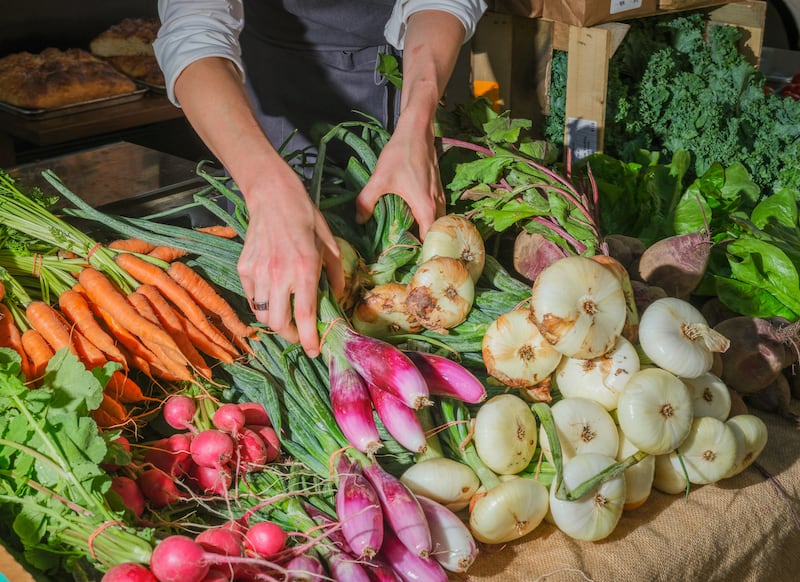Calculating the greenhouse gas (GHG) emissions of human activities is no easy task at the best of times and working out the environmental footprints of specific foods is also a tricky business.
Yet it is widely accepted that the food we eat accounts for between a quarter and one third of global greenhouse gases if you include emissions from processing, packaging, refrigeration and transport of food.
And increasingly, experts agree that tackling the emissions from the food we produce and consume is a crucial part of reducing the global impacts of climate change. For example, sustainable food systems will be a key area of discussion at the Cop28 UN summit in Dubai this November.
However, to get a more holistic picture of the environmental impacts of producing food, we need also to look at other impacts of food production. So, in the past few decades, life cycle assessments (LCAs) have developed to calculate the impact of different foods on land use, water scarcity and water pollution (due to use of chemical fertilisers) as well as their emissions. More recently, these LCAs have also developed nutrient profiling, leading to the so-called nutritional life cycle assessment or nLCA for short.
But a recent study in the scientific journal Nature suggests LCAs don’t adequately capture crucial information about the comparative nutritional value of different foods because they typically compare food items on a mass, volume, calorie or single nutrient basis.
The study – entitled Levelling foods for priority micronutrient value –,can inform more meaningful environmental footprint comparisons. Compiled by Canadian researcher Ryan Katz-Rosene and others it argues that even the more advanced nLCAs don’t sufficiently capture important nutritional complexities of food.
This happens particularly when comparing foods with different dietary functions (eg a principal source of protein versus a source of fat). And – the crux of their argument – they suggest agri-foods sustainability assessments need to better account for nutrient quantity, nutrient quality and/or nutrient diversity.
“We caution that basing sustainable agri-food policy on global mean footprint values could lead to dis-incentivising the sustainable production of foods which have a large average environmental footprint globally but a rather small footprint if produced under specific conditions and production methods in certain geographical contexts (for instance the production of beef using best practices in silvo-pastures or adaptive multi-paddock grazing techniques in contexts where it has proven to support carbon sequestration),” they write. Katz-Rosene is an assistant professor of political studies at the University of Ottawa whose family have an organic farm in Wakefield, Quebec.

So, for example, eggs have a carbon footprint 48 per cent higher than tofu per unit mass and 11 per cent higher per unit energy but when assessed adding their priority micronutrient value, eggs have a carbon footprint 42 per cent lower than tofu.
And the global average carbon footprint of cheese is about eight times larger than that of tofu per kg of retail weight but only about 1.5 times larger once recalculated using the priority micronutrient score system.
The carbon footprint of beef is 21 times that of tofu when measured on a weight basis but when measured using the priority micronutrients value, it is only four times larger. And at the other end of the scale the authors highlight how certain foods that have low environmental footprints per calorie, such as sugar-sweetened drinks or highly-processed snacks, should never be promoted as appropriate food substitutes for nutrient-rich foods merely because of their relatively smaller environmental impacts.
For example, one litre of milk has the same carbon footprint as one litre of a sweetened carbonated drink (2kg of carbon) yet its nutritional value is superior.
[ Activists hold protest in Dublin ahead of United Nations climate talksOpens in new window ]
The Nature study’s authors also acknowledge that while using priority micronutrient value as a metric for comparing food environmental footprints draws attention to the limits of earlier models, it is only one aggregate indicator of nutritional value, and that essential amino acids, essential fatty acids, other essential micronutrients, fibre, phyto-nutrients and bioactive compounds as well as the type of processing of foods, also contribute to the nutritional quality – and play an important role in health and disease.
Dr Sinead McCarthy of Teagasc, a specialist in public health nutrition, has carried out research looking at Irish dietary guidelines and sustainability measures for food commonly consumed in Ireland. She concludes that to make the Irish diet more sustainable while maintaining its nutritional value, we need to reduce the protein shelf of the food pyramid by one portion a day but that we need to halve the amount of so-called discretionary foods (sweets, chocolate, alcohol, etc) on the top shelf of the food pyramid that we consume.

“To stay within dietary guidelines, we need to slightly cut the amount of meat we eat by reducing the protein shelf by one portion a day. This will save about 1.5kg of carbon per day. But, we are eating far in excess of discretionary or treat foods. If we halve the amount of these foods, we can save 1 kg of carbon per day,” she says. If you follow both these recommendations every day for a year, you will reduce your carbon footprint for food equivalent to one transatlantic flight.
McCarthy argues that eating locally-produced and seasonal foods is still the best advice for both human and planetary health. “We could end up with poor health by choosing foods only on the basis of their low carbon footprint so we need to be careful about our food choices. For example, you need to eat four times the amount of plant protein to get the same amount of protein that you get from meat.”
McCarthy also argues that culturally appropriate diets with recommendations for foods available to you and that you know how to cook are important points to consider in sustainable food systems. “If the treats were replaced with three portions of fruit and veg followed by a reduction in meat intake by one portion per day, the healthiness of our diets can be increased and, concurrently, bring about a significant daily reduction of 1.6kg of carbon dioxide a day in GHG emissions,” she adds.

The authors of the Nature study argue that the environmental footprint of a given food varies when you consider the priority micronutrient value rather than a fixed quantity of kilograms, calories or protein. This way of assessing the nutritional value of the food (alongside its sustainability criteria) recommended giving a score based on the unique quantities for each food that provides on average one-third of the recommended intakes across six micronutrients commonly lacking globally (iron, zinc, folate, calcium, vitamin A and vitamin B12).
“Levelling food for priority micronutrient value enables a more nuanced and dynamic interpretation of the food-environment trade-offs involved in food substitution (eg replacing animal-source foods with plant-source foods),” they add. So, using this metric, about 440g of peas is equivalent to 7g of animal liver, 113g of beef or 177g of eggs.
[ ‘Plant-based diet’ term confusing for consumers — National Dairy CouncilOpens in new window ]
“This presents a challenge for sustainable agri-food policy at both the population and individual levels as the promotion of food substitution for the sake of environmental sustainability may come at the expense of greater nutritional risk, particularly for more vulnerable populations,” they note.
This issue becomes more important when you consider micronutrient deficiencies such as iron, zinc and folate deficiency, which are common worldwide but especially in low- and middle-income countries and among women of reproductive age and other groups with increased nutrient requirements (eg young children and pregnant and lactating women).
Professor of sustainable energy at University College Cork Hannah Daly says the typical Irish diet is still too high in protein as well as being a carbon-intensive diet.
“The nutrient and environmental qualities of different foods are complex and multidimensional. Nevertheless, there is a consensus that diets can be nutritionally adequate with far lower and even no animal products and that reducing consumption of meat and other animal-sourced foods in developed countries like Ireland can make a significant difference in limiting climate change and biodiversity loss.”
Daly says that including foods’ climate footprint within the food pyramid and information on healthy whole plant-based alternatives to animal-based foods would help Irish people make better informed dietary choices.












